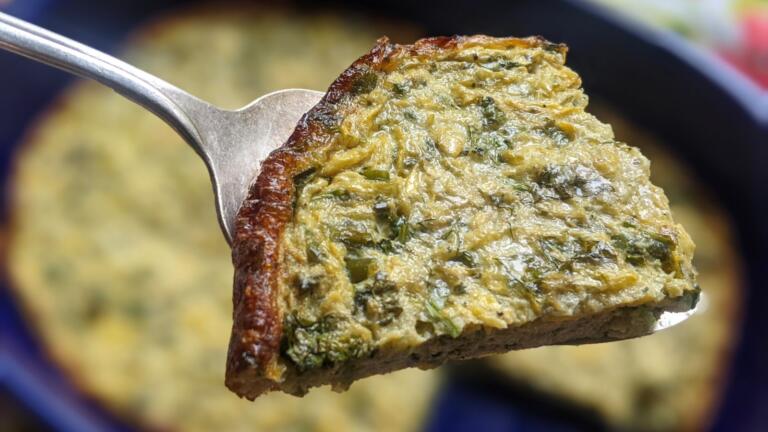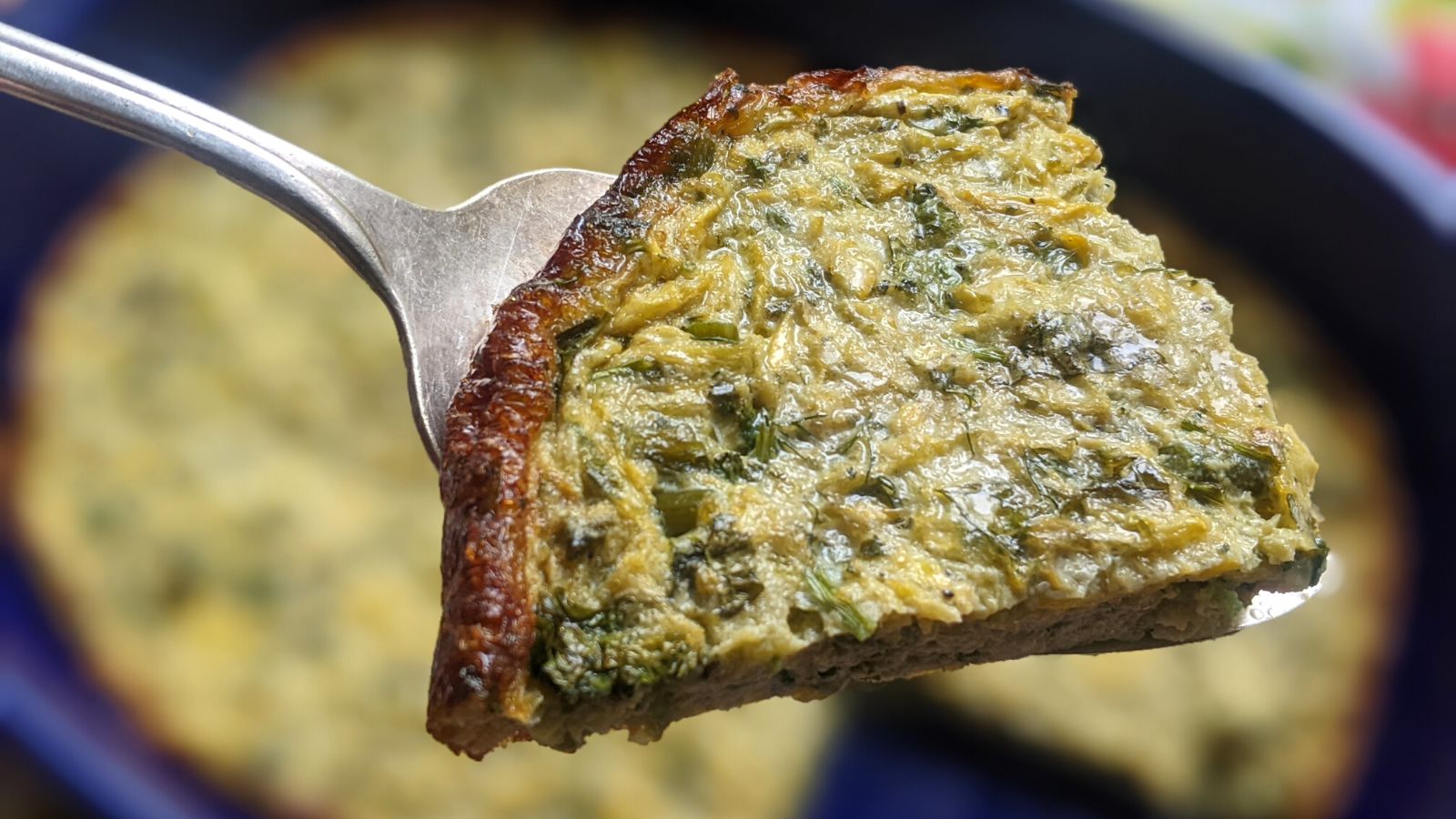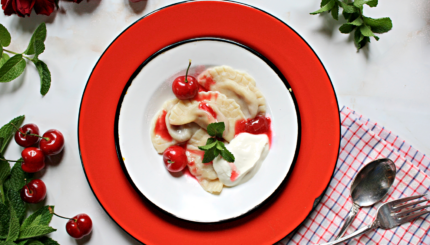As those of us familiar with Sephardic cuisine know, there are often different names and spellings for similar dishes. When it comes to baked casseroles of vegetables, egg and usually cheese, it could be called a kuajado or quajado, sfongato or asfongato, fritada or frittata. Most often, “almodrote” is used by Turkish Jews when the dish is made with zucchini. “Kalabaza” (or calabaza) refers to squash, and is often used to describe different varieties of the vegetable.
Whatever it’s called, some form of this baked dish is nearly always served during Passover in Sephardic homes, and is usually included in the seder meal. It’s especially convenient because it can be made a day or two ahead (more if you want to freeze it) and doesn’t need to take up precious oven space, as it’s often served at room temperature or just barely warmed through. Almodrote and friends are also good for breakfast when you get tired of eating matzah and leftover haroset, or for lunch, dinner or cut into small squares for an appetizer.
This basic recipe can be adapted in many ways. While it calls for feta and parmesan, cheddar or kashkaval (a semi-hard cheese most often made from sheep’s milk that’s popular throughout the Balkans and Mediterranean), the cheese can be left out altogether to make it pareve, or you can use vegan cheese. Regular or gluten-free matzah meal can be used, or bread crumbs when it’s not Passover. You can also make it with other vegetables, including eggplant (berendjena), spinach (espinaka) or leeks (prasa), or add more of the herbs.
Traditionally in the no-waste Sephardic kitchen, the squash would be peeled and the peels made into a different dish. This dish, called kashkarikas, involves cooking the peels in a lemon and olive oil sauce, or with tomatoes and garlic. However, for extra nutrition and flavor, I don’t peel my squash.
The Nosher celebrates the traditions and recipes that have brought Jews together for centuries. Donate today to keep The Nosher's stories and recipes accessible to all.
Note: Cooked almodrote can be refrigerated for up to five days or frozen, well wrapped, for up to two months. To serve, defrost and heat in a 350°F oven, uncovered, for about 15 minutes, or until just warmed through.

Sephardic Zucchini Casserole
This egg, veg and cheese casserole is a staple Sephardic Passover dish, eaten at any time of day.
- Total Time: 1 hour 20 minutes
- Yield: Serves 4-6
Ingredients
- 5–6 medium zucchini (about 3 lb or 5 cups grated)
- 2 tsp salt, plus more to taste
- 3 eggs, lightly beaten
- ¼ cup chopped fresh dill
- ¼ cup chopped fresh parsley
- 2 Tbsp matzah meal or bread crumbs
- ⅔ cup feta cheese, crumbled
- ½ cup shredded cheese (parmesan, cheddar or kashkaval — available at Middle Eastern and other specialty markets)
- ½ tsp black pepper
- 3 Tbsp olive oil
Instructions
- Preheat oven to 350°F.
- Wash the zucchini well and grate on the large holes of a box grater or using a food processor. Put into a strainer and sprinkle with 2 tsp salt, tossing lightly with your hands to distribute the salt. Put a plate on top of the squash to weigh it down, and set the strainer over a bowl or in the sink for 15-20 minutes as the zucchini releases some excess water content.
- In a large bowl, mix together the eggs, dill, parsley, matzah meal or bread crumbs, feta, shredded cheese and pepper until very well blended.
- Take small handfuls of zucchini and squeeze out as much water as you can before adding each handful to the egg mixture. Mix well.
- Swirl 2 Tbsp oil over the bottom and sides of a 7×11- or 9×9-inch baking dish, then place it in the hot oven for 3-4 minutes. Heating the pan with the oil helps create a crust on the bottom and sides of the casserole. Once the baking dish is hot, carefully remove it from the oven. Working quickly, add the mixture to the pan and spread it out evenly, patting the top smooth. Lightly brush the top with the remaining 1 Tbsp oil. Bake, uncovered, about 45-50 minutes, or until the center is firm and the top and edges are golden brown.
- Let cool for 10 minutes before cutting, if serving immediately. Serve warm or at room temperature.
Notes
Cooked almodrote can be refrigerated for up to five days or frozen, well wrapped, for up to two months. To serve, defrost and heat in a 350°F oven, uncovered, for about 15 minutes, or until just warmed through.
- Prep Time: 30 minutes
- Cook Time: 50 minutes
- Category: Breakfast
- Method: Baking
- Cuisine: Sephardic




Looks delicious! Here in Mexico I have a variety of squash and an assortment of cheeses I can try this with!
This was just great. Easy to make and infinately adaptable to whatever veg are available. Oh, I used a 10-inch cast iron pan, warmed it in the oven as the recipe says, and it was perfect.
Big winner. We followed the recipe fairly closely, though without parsley and a bit more black pepper, sweet paprika and some garlic powder, we also cooked it in a loaf pan. We will definitely make this again, when it’s not Pesach.
How can I adapt to make it dairy free?
Hi Sifrah! While we haven’t tested it this way, you might consider looking for a dairy-free cheese substitute that is salty in the same way parmesan and cheddar are.
Delish! Next time I make this I will add more feta.
Thanks for all the great recipes. 💙🇮🇱💙